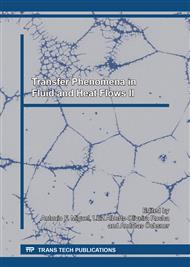[1]
Y. Goda, Randon Seas and Design of Maritime Structures, World Scientific Publishing, Advanced Series on Ocean Engineering, v. 15, (2010).
Google Scholar
[2]
P. A. Madsen, R. Murray, O. R. Sørensen, A new form of the Boussinesq equations with improved linear dispersion characteristics, Coastal Engineering. 15 (1991) 371-388.
DOI: 10.1016/0378-3839(91)90017-b
Google Scholar
[3]
P. A. Madsen, O. R. Sørensen, A new form of the Boussinesq equations with improved linear dispersion characteristics. Part 2. A slowly-varying bathymetry, Coastal Engineering. 18 (1992) 183-204.
DOI: 10.1016/0378-3839(92)90019-q
Google Scholar
[4]
P. A. Madsen, J. Larsen, An Efficient Finite-Difference Approach to the Mild-Slope Equation, Coastal Engineering. 11 (1987) 329-351.
DOI: 10.1016/0378-3839(87)90032-9
Google Scholar
[5]
N. Booij, R. C. Ris, L. H. Holthuijsen, A third-generation wave model for coastal regions 1. Model description and validation, Journal of Geophysical Research. 104 (1999) 7649-7666.
DOI: 10.1029/98jc02622
Google Scholar
[6]
J. L. Lara, N. Garcia, I J. Losada, RANS modeling applied to random wave interaction with submerged permeable structures, Coastal Engineering. 53 (2006) 395 – 417.
DOI: 10.1016/j.coastaleng.2005.11.003
Google Scholar
[7]
J. L. Lara, A. Ruju, I. J. Losada, Reynolds averaged Navier-Stokes modelling of long waves induced by a transient wave group on a beach, Proceedings of the royal society A. 467 (2011) 1215 – 1242.
DOI: 10.1098/rspa.2010.0331
Google Scholar
[8]
P. Higuera, J. L. Lara, I. J. Losada, Realistic wave generation and active wave absorption for Navier-Stokes models Application to OpenFOAM®, Coastal Engineering. 71 (2013) 102 – 118.
DOI: 10.1016/j.coastaleng.2012.07.002
Google Scholar
[9]
ANSYS, Fluent User's Guide, 2015 a.
Google Scholar
[10]
K. Hasselmann, T. P. Barnett, E. Bouws, H. Carlson, D. E. Cartwright, K. Enke, J. A. Ewing, H. Gienapp, D. E. Hasselmann, P. Kruseman, A. Meerburn, P. Müller, D. J. Olbers, K. Richter, W. Sell, H. Walden. Measurements of wind-wave growth and swell decay during the Joint North Sea Wave Project (JONSWAP). Deutsche Hydrographische Zeitschrift, (8), Reihe A, (1973).
Google Scholar
[11]
P. J. Zwart, P. G. Godin, J. Penrose, S. H. Rhee, Ship Hull Simulations with a Coupled Solution Algorithm, Proceedings of the 10th International Symposium on Practical Designs of Ships and Other Floating Structures, Houston, TX, (2007).
Google Scholar
[12]
J. C. Park, M. H. Kim, H. Mitaya, Fully non-linear free surface simulation by a 3D viscous numerical wave tank, International Journal for Numerical Method in Fluids. 29 (1999) 685 – 703.
DOI: 10.1002/(sici)1097-0363(19990330)29:6<685::aid-fld807>3.0.co;2-d
Google Scholar
[13]
R. Péric and M. Abdel-Maksoud, Reliable damping of free-surface waves in numerical simulations, Ship Technology Research. 63 (2016) 1 – 13.
DOI: 10.1080/09377255.2015.1119921
Google Scholar
[14]
H. Versteeg and W. Malalasekera, An Introduction to Computational Fluid Dynamics: The Finite Volume Method, Pearson, ed. 2, (2007).
Google Scholar
[15]
C. W. Hirt and B. D. Nichols, B. D., Volume of fluid (VOF) method for the dynamics of free boundaries, Journal of Computational Physics. 39 (1981) 201 – 225.
DOI: 10.1016/0021-9991(81)90145-5
Google Scholar
[16]
ANSYS, Fluent Theory Guide, 2015 b.
Google Scholar
[17]
K. O. Cornell and A. Cashman, Development of a numerical wave tank with reduced discretization error, Proceedings of the International Conference on Electrical, Electronics and Optimization Techniques (ICEEOT), (2016).
DOI: 10.1109/iceeot.2016.7755252
Google Scholar
[18]
Det Norske Veritas, Recommended Practice DNV-RP-C205 - Environmental Conditions and Environmental Loads, (2010).
Google Scholar
[19]
ANSYS, Gambit User's Guide, (2007).
Google Scholar
[20]
R. Dean and R. A. Dalrymple, Water Wave Mechanics for Engineers and Scientists, World Scientific Publishing, Advanced Series on Ocean Engineering, v. 2, (1991).
DOI: 10.1142/1232
Google Scholar


